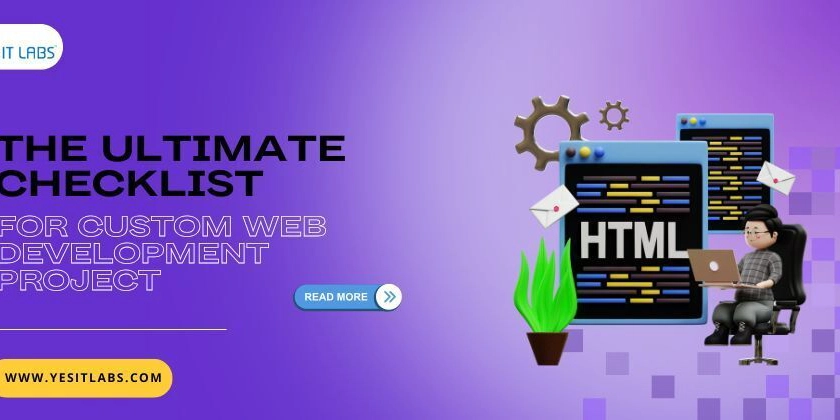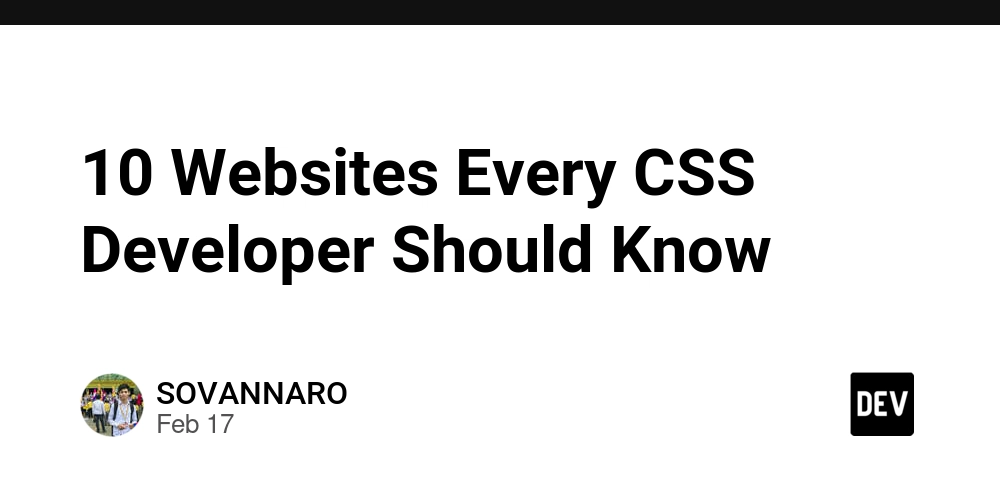The Ultimate Checklist for Your Custom Web Development Project
Embarking on a custom web development project can be both exciting and challenging. To achieve success, it’s essential to follow a well-organized process that covers all the important steps. Here’s an expert guide with valuable insights from YES IT Labs, a top-tier web and software development company. 1. Clarify Your Website's Purpose The first step in any custom web development project is to have a clear understanding of your website’s objectives. Do you aim to increase your revenue, engage with customers more effectively, or simply provide key information? Defining these goals upfront will help guide the design, development, and functionality of your website. Be sure to set goals that are specific, measurable, achievable, relevant, and time-bound (SMART). 2. Conduct Thorough Research Research is crucial to understand the audience, competitors, and the latest trends in your industry. This knowledge will help you create a website that not only meets user needs but also stands out from the competition. It’s also essential to know what’s working well for competitors and identify opportunities to innovate. Your planning stage should include: A detailed site structure or map. Understanding the user journey, which ensures a smooth navigation experience. Defining the core features and functionalities that align with your business strategy. 3. Select the Best Technology for Your Needs Choosing the right technology stack is vital for ensuring the project’s long-term scalability, performance, and maintenance. YES IT Labs is proficient in various technologies such as PHP, WordPress, Magento, Laravel, Node.js, React.js, and more. When deciding, consider: The scope of your website (e.g., small business versus enterprise-grade). Your security requirements (e.g., encryption and secure user authentication). How quickly you need to build and launch (e.g., using frameworks that speed up development, such as Laravel or React.js). Anticipated growth and integration needs, such as connecting with other applications or services. You’ll also need to choose a suitable database system based on your data handling requirements, whether it’s relational (SQL) or non-relational (NoSQL). 4. Focus on Design and User Experience (UX) An appealing and user-friendly design is essential for the success of your website. You should ensure that the site is not only aesthetically pleasing but also intuitive and easy to navigate. Consider the following elements: A flexible design that adjusts to different screen dimensions. Accessibility for users with disabilities, ensuring compliance with standards like WCAG (Web Content Accessibility Guidelines). A mobile-first approach, as mobile optimization is key to both SEO and user experience. Testing early prototypes with real users to gather actionable feedback. 5. Development: Building the Core Functionality Once the planning and design phases are complete, the development stage begins. It's essential to follow industry best practices to ensure high-quality, maintainable code: Set up a development environment using version control systems like Git to track changes. Use clean, modular, and reusable code to ensure the website is easy to maintain and scale. Consider implementing scalable architecture, allowing the website to grow as your user base and traffic increase. You may want to explore options like microservices for flexibility or serverless architectures for efficient resource management. Prioritize API integrations if you need to connect your site with third-party services. If you're planning to hire PHP programmers, look for developers with expertise in PHP frameworks like Laravel or CodeIgniter. These frameworks will help you build a flexible, secure, and high-performing custom web solution. 6. Testing and Quality Assurance Thorough testing is necessary to ensure that your website functions flawlessly. Comprehensive QA should include: Unit tests to check individual components. End-to-end testing to validate full workflows and interactions. Cross-browser testing to confirm the website performs well across different browsers. Performance testing to assess page load times and responsiveness. Security testing to safeguard against vulnerabilities like SQL injection, cross-site scripting (XSS), and data breaches. User acceptance testing (UAT) should also be conducted with real users to ensure the website meets their expectations. 7. SEO and Content Strategy To attract organic traffic, you need a well-defined SEO and content strategy: Keyword research is crucial to optimize content for search engines. On-page SEO includes optimizing page titles, meta descriptions, headings, and image alt text. Implement technical SEO to improve your site’s loading speed, mobile-friendliness, and URL structure. Regularly update your website with high-quality content that addresses the needs and questions of your aud

Embarking on a custom web development project can be both exciting and challenging. To achieve success, it’s essential to follow a well-organized process that covers all the important steps. Here’s an expert guide with valuable insights from YES IT Labs, a top-tier web and software development company.
1. Clarify Your Website's Purpose
The first step in any custom web development project is to have a clear understanding of your website’s objectives. Do you aim to increase your revenue, engage with customers more effectively, or simply provide key information? Defining these goals upfront will help guide the design, development, and functionality of your website. Be sure to set goals that are specific, measurable, achievable, relevant, and time-bound (SMART).
2. Conduct Thorough Research
Research is crucial to understand the audience, competitors, and the latest trends in your industry. This knowledge will help you create a website that not only meets user needs but also stands out from the competition. It’s also essential to know what’s working well for competitors and identify opportunities to innovate.
Your planning stage should include:
A detailed site structure or map.
Understanding the user journey, which ensures a smooth navigation experience.
Defining the core features and functionalities that align with your business strategy.
3. Select the Best Technology for Your Needs
Choosing the right technology stack is vital for ensuring the project’s long-term scalability, performance, and maintenance. YES IT Labs is proficient in various technologies such as PHP, WordPress, Magento, Laravel, Node.js, React.js, and more. When deciding, consider:
The scope of your website (e.g., small business versus enterprise-grade).
Your security requirements (e.g., encryption and secure user authentication).
How quickly you need to build and launch (e.g., using frameworks that speed up development, such as Laravel or React.js).
Anticipated growth and integration needs, such as connecting with other applications or services.
You’ll also need to choose a suitable database system based on your data handling requirements, whether it’s relational (SQL) or non-relational (NoSQL).
4. Focus on Design and User Experience (UX)
An appealing and user-friendly design is essential for the success of your website. You should ensure that the site is not only aesthetically pleasing but also intuitive and easy to navigate. Consider the following elements:
A flexible design that adjusts to different screen dimensions.
Accessibility for users with disabilities, ensuring compliance with standards like WCAG (Web Content Accessibility Guidelines).
A mobile-first approach, as mobile optimization is key to both SEO and user experience.
Testing early prototypes with real users to gather actionable feedback.
5. Development: Building the Core Functionality
Once the planning and design phases are complete, the development stage begins. It's essential to follow industry best practices to ensure high-quality, maintainable code:
Set up a development environment using version control systems like Git to track changes.
Use clean, modular, and reusable code to ensure the website is easy to maintain and scale.
Consider implementing scalable architecture, allowing the website to grow as your user base and traffic increase. You may want to explore options like microservices for flexibility or serverless architectures for efficient resource management.
Prioritize API integrations if you need to connect your site with third-party services.
If you're planning to hire PHP programmers, look for developers with expertise in PHP frameworks like Laravel or CodeIgniter. These frameworks will help you build a flexible, secure, and high-performing custom web solution.
6. Testing and Quality Assurance
Thorough testing is necessary to ensure that your website functions flawlessly. Comprehensive QA should include:
Unit tests to check individual components.
End-to-end testing to validate full workflows and interactions.
Cross-browser testing to confirm the website performs well across different browsers.
Performance testing to assess page load times and responsiveness.
Security testing to safeguard against vulnerabilities like SQL injection, cross-site scripting (XSS), and data breaches.
User acceptance testing (UAT) should also be conducted with real users to ensure the website meets their expectations.
7. SEO and Content Strategy
To attract organic traffic, you need a well-defined SEO and content strategy:
Keyword research is crucial to optimize content for search engines.
On-page SEO includes optimizing page titles, meta descriptions, headings, and image alt text.
Implement technical SEO to improve your site’s loading speed, mobile-friendliness, and URL structure.
Regularly update your website with high-quality content that addresses the needs and questions of your audience.
8. Preparing for Launch
Before launching, you need to make sure everything is set up and fully functional:
Web hosting: Choose a hosting solution that can handle your site's traffic, whether that’s shared, VPS, or cloud hosting.
Domain name and DNS configuration.
Implement SSL certificates for secure data transmission and trustworthiness.
Perform a final review to ensure all features, forms, and integrations are working properly.
9. Post-Launch Monitoring
Once your website is live, continuous monitoring is essential. Use tools like Google Analytics and Hotjar to track user behavior and performance. Regular activities include:
Monitoring site uptime and ensuring fast load times.
Collecting user feedback through surveys or analytics tools.
Making regular updates to fix bugs or improve functionality based on feedback.
Keeping content fresh and optimizing for SEO.
10. Ongoing Maintenance and Support
Websites require regular maintenance to stay secure and perform optimally. Some key activities include:
Software updates: Keep all CMS, plugins, and libraries up-to-date to prevent security breaches.
Security monitoring: Regular vulnerability assessments to patch potential threats.
Regular backups to safeguard your data.
User feedback analysis to continue improving the site and meeting evolving business goals.
YES IT Labs also provides ongoing support, ensuring that your website remains up-to-date, secure, and aligned with your business objectives.
By following these structured steps, you can successfully complete your custom web development project. A methodical approach, paired with expert guidance from experienced professionals like YES IT Labs, will ensure that your website meets your business goals and delivers a top-notch user experience.











































































































































































![[The AI Show Episode 142]: ChatGPT’s New Image Generator, Studio Ghibli Craze and Backlash, Gemini 2.5, OpenAI Academy, 4o Updates, Vibe Marketing & xAI Acquires X](https://www.marketingaiinstitute.com/hubfs/ep%20142%20cover.png)




























































































































![[DEALS] The Premium Learn to Code Certification Bundle (97% off) & Other Deals Up To 98% Off – Offers End Soon!](https://www.javacodegeeks.com/wp-content/uploads/2012/12/jcg-logo.jpg)


![From drop-out to software architect with Jason Lengstorf [Podcast #167]](https://cdn.hashnode.com/res/hashnode/image/upload/v1743796461357/f3d19cd7-e6f5-4d7c-8bfc-eb974bc8da68.png?#)








































































































.png?#)























.webp?#)










_Christophe_Coat_Alamy.jpg?#)
 (1).webp?#)




































































































![Apple Considers Delaying Smart Home Hub Until 2026 [Gurman]](https://www.iclarified.com/images/news/96946/96946/96946-640.jpg)
![iPhone 17 Pro Won't Feature Two-Toned Back [Gurman]](https://www.iclarified.com/images/news/96944/96944/96944-640.jpg)
![Tariffs Threaten Apple's $999 iPhone Price Point in the U.S. [Gurman]](https://www.iclarified.com/images/news/96943/96943/96943-640.jpg)



































































































































